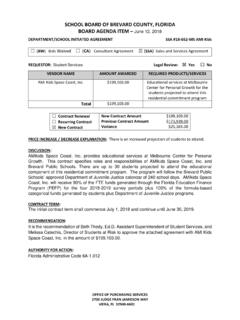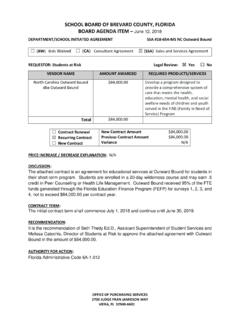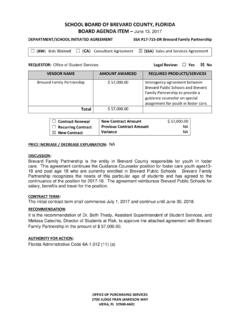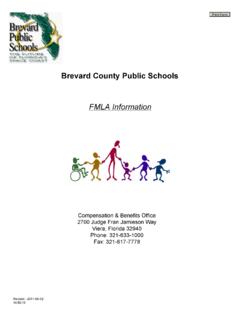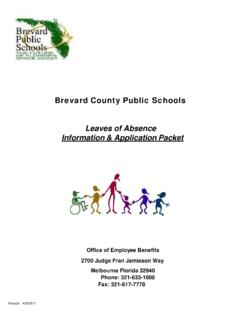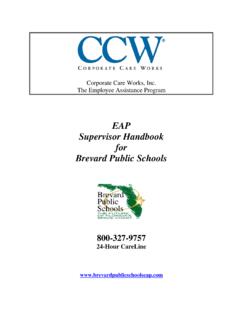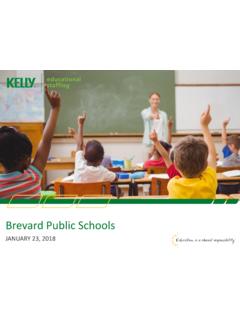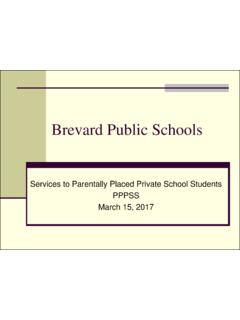Transcription of Brevard County Public Schools School Improvement Plan …
1 Page 1 Brevard County Public Schools School Improvement plan 2012-2013 Name of School : Area: Principal: Area Superintendent: SAC Chairperson: Superintendent: Dr. Brian Binggeli Mission Statement: Lockmar parents, staff and students will strive to achieve our vision for excellence: ACHIEVEMENT- To continue the pursuit of outstanding academic performance. CURRICULUM - To monitor our curriculum and update technological areas for the future needs of our children and society.
2 UNITY - To unify the staff, students, parents, and members of the community to mold Lockmar into extended family. RESPECT - To develop self-esteem, respect for others and positive attitudes. COMMUNITY- To use all resources in providing enrichment experiences for our students. Vision Statement: LOCKMAR, WHERE MINDS OPEN TO THE FUTURE Lockmar Elementary School South Area Mrs. Norma L. Hostetler Dr. Mark W. Mullins Mrs. Linette H. Lochner Page 2 Brevard County Public Schools School Improvement plan 2012-2013 RATIONAL Continuous Improvement Cycle Process Data Analysis from multiple data sources: (Needs assessment that supports the need for Improvement ) In analyzing our data from 2011-2012, the number of points earned for the School Grade increased from 579 to 617.
3 Students at the Lowest 25% in both reading and math exceeded the set target for Improvement . o Reading 2011 77% 2012 87% o Math 2011 58% 2012 72% Learning gains for all students in both reading and math exceeded their established target for Improvement . o Reading 2011 66% to 2012 77% o Math 2011 57% to 2012 74% The target for Improvement in both science and writing was also exceeded. o Science 2011 61% to 2012 70% o Writing 2011 85% to 2012 87% Three subgroups (White, Hispanic & the Economically Disadvantaged) did not meet their targets for Improvement in reading and math.
4 The data that was available included all curriculum groups since the 2012 School Report card data is not currently available. Although our overall attendance rate is above 95%, attendance records indicate 77% of absences are unexcused. students must be present to increase instructional time, which will affect student achievement. Although our attendance rate is at or above the district goal, the amount of unexcused absences is extremely high. In order for students to be successful, attendance in crucial therefore, we encourage attendance unless students are ill. o By grade level and % of unexcused absences: K 486/630 77% 1st 382/505 76% 2nd 411/596 75% 3rd 610/718 85% 4th 419/528 79% 5th 425/574 74% 6th 552/750 74% Teacher survey indicates a need for additional training to foster the implementation of higher order thinking skills necessary in Common Core State Standards (CCSS).
5 Best Practice: (What does research tell us we should be doing as it relates to data analysis above?) Robert J. Marzano s book Classroom Instruction That Works, contains nine strategies to help teachers increase their students achievement. At Lockmar, we have focused on the implementation of three of these instructional strategies: Page 3 Identifying Similarities and Differences; Cues, Questions, and Advance Organizers; and Nonlinguistic Representations. After analyzing our data, for 2012-2013 we will continue to use these strategies, and we will add three more to address the areas we feel need Improvement .
6 The three strategies we chose are strategies that we feel are being under-used or not used at all. The strategies are: Summarizing and Note Taking (to advance our Level 3 students), Setting Objectives and Providing Feedback; and Generating and Testing Hypotheses (for all students). Summarizing and Note Taking: According to Marzano, Although we sometimes refer to summarizing and note taking as mere study skills, they are two of the most powerful skills students can cultivate. They provide students with tools for identifying and understanding the most important aspects of what they are learning.
7 (Classroom Instruction that Works, pg. 48) To effectively summarize, students must be able to analyze information at a fairly deep level to effectively delete, substitute, and keep information. Students must also be aware of the explicit structure of information which will aid in summarizing information. Note taking is closely related to summarizing. To take effective notes, a student must be able to determine what is most important, and then state that information in a concise way. Applications: Science Interactive Notebooks, Discovery Learning, DBQ s, Math Journals, Reading Journals Setting Objectives and Providing Feedback: Setting objectives is the process of establishing a direction for learning.
8 This is helpful for realizing short and long-term goals. Feedback should be given relative to how well the student is doing. According to Marzano, feedback should be corrective in nature, timely, and specific to a criterion. Students can effectively provide some of their own feedback. (Classroom Instruction that Works, pg. 96) Applications: Student-Led Conferences, Reading Counts, assessments, classroom behavior, personal learning goals, Generating and Testing Hypotheses: According to Marzano, this instructional strategy is one of the most powerful and analytic of cognitive operations.
9 This process involves the application of knowledge. It is something we often do naturally in many situations. The hypothesis generation and testing can be inductive or deductive, and teachers should ask students to clearly explain their hypotheses and their conclusions. Applications: Science projects, student-designed projects in any subject area, reading predictions, creating inventions, decision making, problem solving, Continuing to study and implement Marzano s strategies will assist our teachers and help them to scaffold their instructional growth for individualized student achievement at all levels.
10 Analysis of Current Practice: (How do we currently conduct business?) In 2011-2012, we advanced our use of the Continuous Improvement Cycle (Learn, plan , Do, Measure) and BEST s Dimensions of Success Model (Results, Relationships, Process). We used data to drive instruction, and this instruction was based on BEST practices, Marzano s Classroom Instruction that Works Research-Based Strategies, and other research-based strategies such as CRISS, ESOL, Thinking Maps, Glasser, Multiple Intelligences, 4 MAT, and others. Our Academic Support Program, which focused on Reading, Math and Science, addressed the needs of substantially deficient students.
